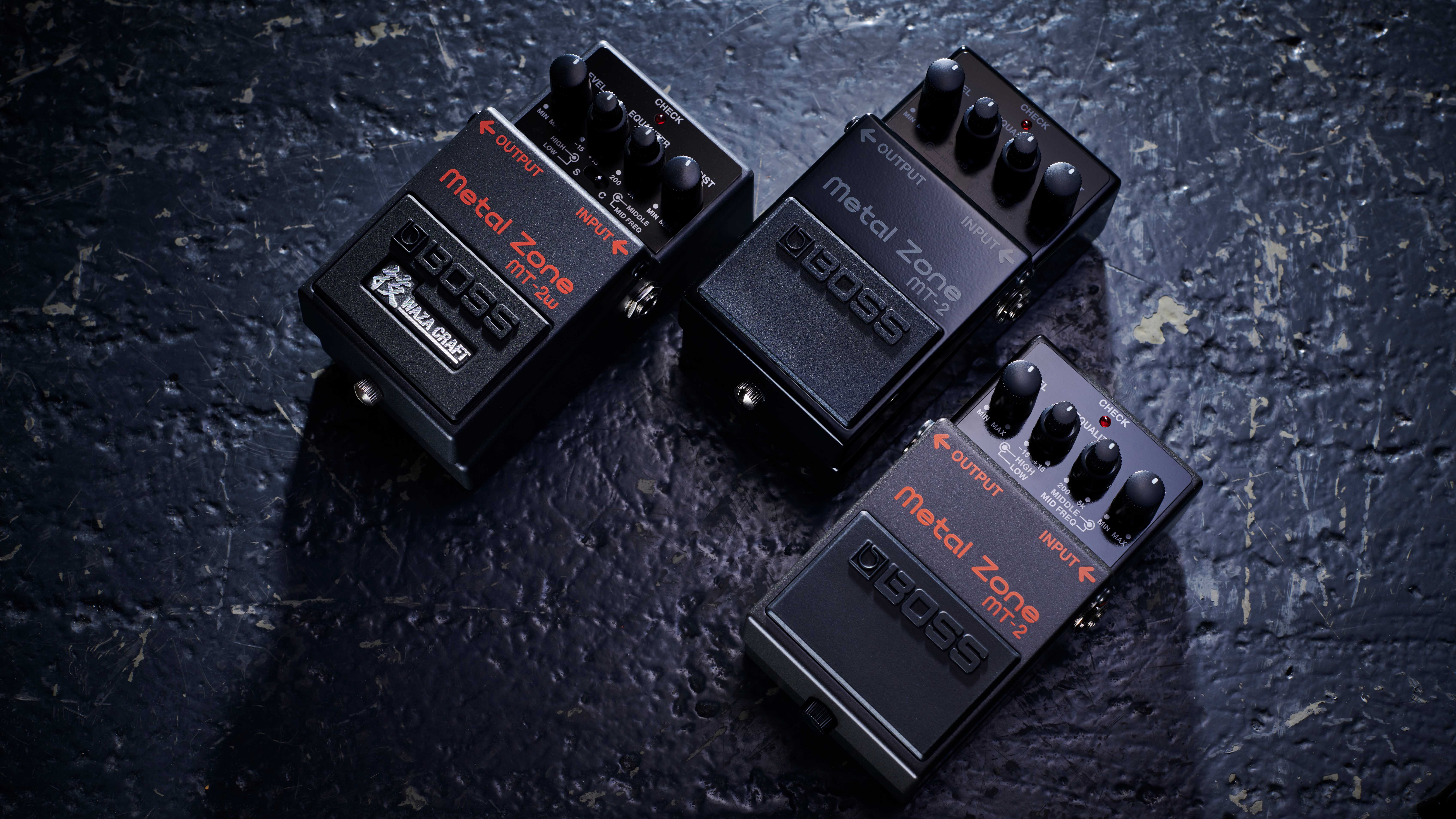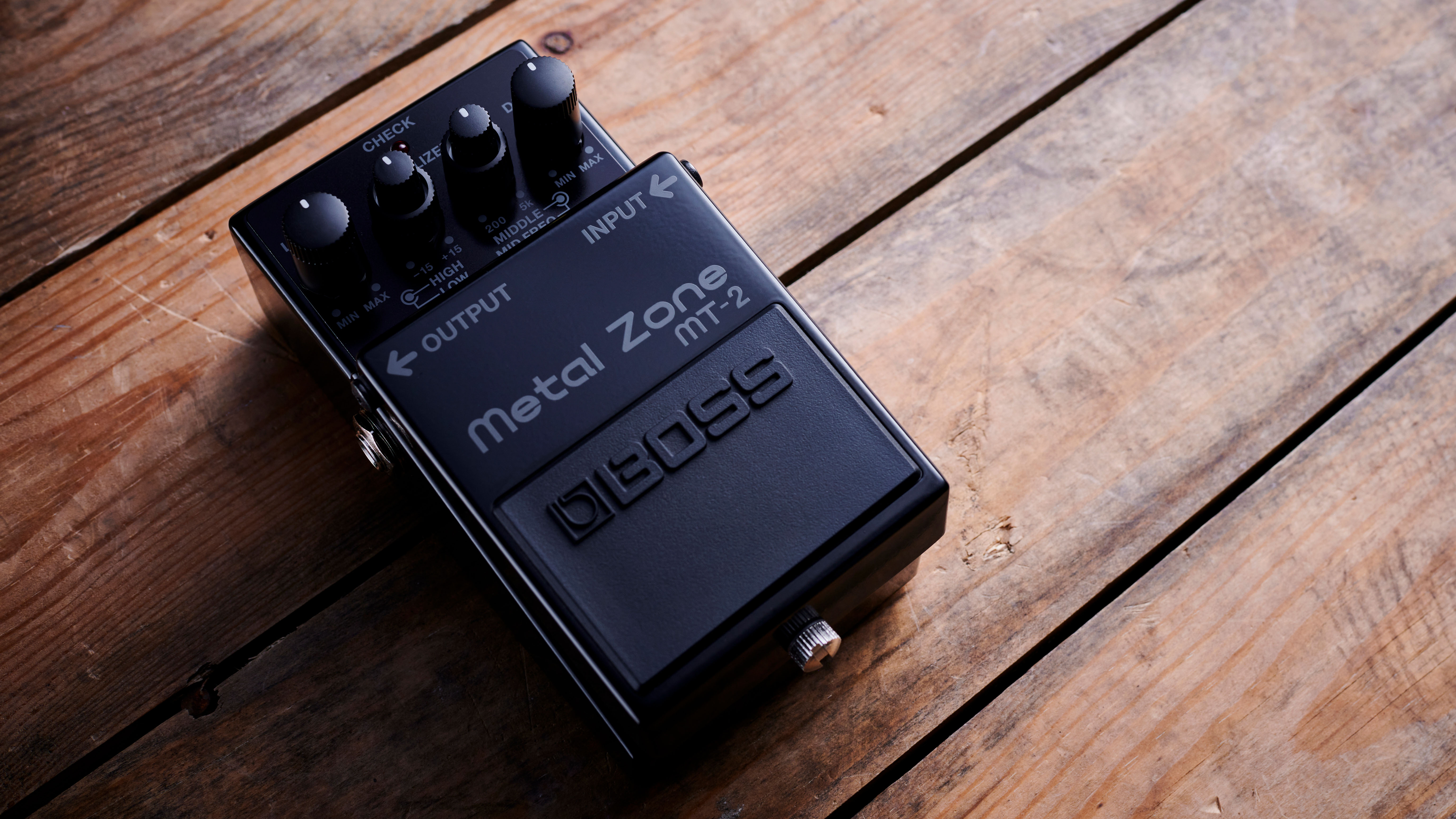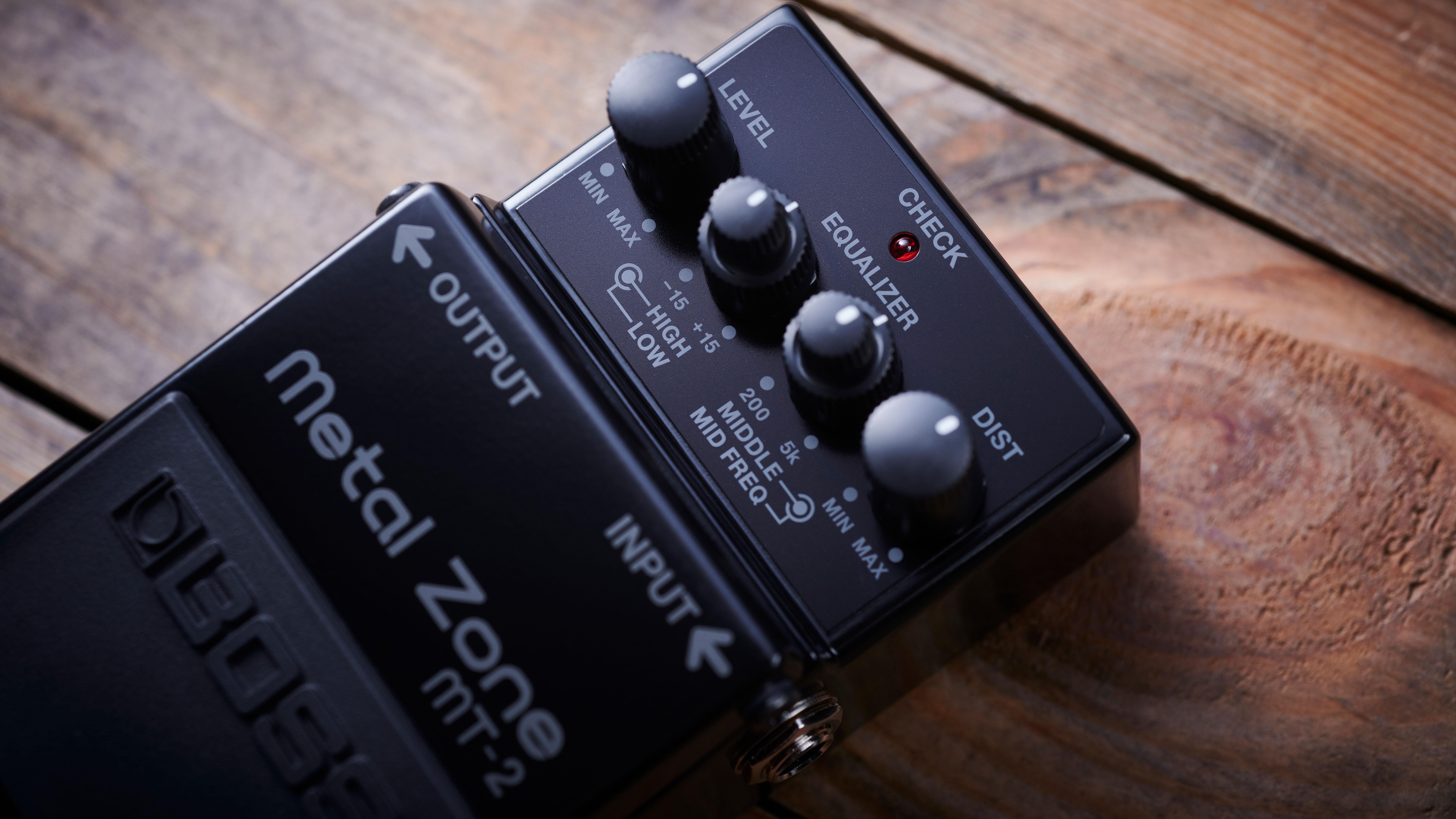
As it reaches its 30th anniversary, the Boss MT-2 Metal Zone has already passed the incredible landmark of selling over a million pedals. A mind-bogglingly high number for any guitar effects unit, especially a high-gain distortion pedal that remains one of the company's most misunderstood.
The pedal's huge potential lies goes beyond the obvious strength of its huge gain range, with Low, Middle, and High controls offering +15 dB cut or boost to carefully tweak your tone for amp and guitar.

As the Metal Zone receives a special none-more-black 30th Anniversary Limited Edition MT-2-3A version for 2021, it's a great opportunity to take stock and celebrate the diverse range of musicians who have taken advantage of the MT-2's tonal strengths and what we can learn from its greatest moments on record and stage.
And it's not always used for the guitar…
Biffy Clyro - 57
From small clubs as a power trio in Biffy Clyro's early days to stadium headliners, Simon Neil's drive sound has always been huge, and hugely reliant on the Boss MT-2 Metal Zone. "The level… you can take it wherever you want it to be but I find if it's not at three quarters it doesn't have that step up that I require," Neil explained to That Pedal Show last year. Neil also stressed the sensitivity of the MT-2's EQ adjustment on the pedal in the video below, a key factor in the pedal's strengths.
It’s a big, serious, scooped distortion
He's always used stock Metal Zones and the basic settings remain no matter what amp the singer/guitarist uses. “Simon’s got the Level up to 3 o’clock and the Distortion set to just over halfway,” his tech Richard Pratt revealed to Boss. “We’re pushing the Low to 3 o’clock; High is at 12 o’clock, and we pull both the midrange knobs back to around 10 o’clock. The Low boost gives the sound girth. It’s a big, serious, scooped distortion."
Neil's choice of a main mid-focussed guitar with overwound single-coils is also a factor in how effective the MT-2 has become for Biffy Clyro's sound; "The saturation of everything, as well as the clarity of that [Fender] Supersonic and the punch of the Stratocaster, that's quite an important part," he explains. "I'm not sure a Les Paul would react in quite the same way.
Get the MusicRadar Newsletter
Want all the hottest music and gear news, reviews, deals, features and more, direct to your inbox? Sign up here.
Another key component is Neil is using the the Supersonic clean for a fuller and defined chord experience to capture the highs while being combined by the Metal Zone is going into his Marshall 1959 SLP reissue head.
Daft Punk - Rollin' And Scratchin'
Well here's a curveball already – the enigmatic French duo reportedly used a Boss MT-2 with a 1984 Juno 106 synth for this relentless cut from their 1997 debut album Homework . Guy-Manuel de Homem-Christo and Thomas Bangalter were not the most talkative at the best of times but YouTuber Alex Ball makes a strong case in the video tutorial below that the MT-2 was used on the track, using a Juno-06 with it to accurately recreate the harsh, pulverising sound.
The MT-2 transforms the Juno's soft sound by maxing all settings, and it compresses the sound into the realms of Beelzebub. The power of the Metal Zone's EQ pots are fully on show here.
Prince - The Undertaker
The story around The Undertaker is fascinating in its own right; it's the Purple One in his guitar hero element, but it remains officially unreleased. Recorded live in one take at Paisley Park on 14 June, 1993, it was meant to be released as a cover-mount CD with Guitar World magazine but the release was blocked by Prince's then record label, Warner Bros.
The 36-minute album has since surfaced on YouTube and cements Prince's legacy as an incredibly gifted guitarist. And one who long relied on a 'board of Boss pedals – with a Metal Zone on the road for the Diamonds and Pearls tour and up until the late '90s. But it's on this album that it can be heard in high-gain glory.
At The Gates – Blinded By Fear
While the HM-2 was the defining element of the Swedish death metal sound of the '90s, for the crowning glory of the comparatively melodic side of the sound that was based around the city of Gothenburg, the MT-2 was paired with it. To devastating effect.
The HM-2 was run into the MT-2 with a solid state Peavey Supreme 160 head for tracking at Fredrik Nordström's Studio Fredman with 10" and 12" speakers. The Metal Zones effectively tightened the high gain sound of the HM-2 for Anders Björler and Martin Larsson's intricate Wagnerian riffs.
Korn - Did My Time
Korn's James 'Munky' Shaffer has used Boss pedals for his palette of eery tones for years and proves the Metal Zone is great fo lo-fi intros when dialled back. "It's something I picked for a song a long time ago, Did My Time, and it turns it into an AM radio sound, a lo-fi sound is what we use that for," his tech Jim Otell told Premier Guitar.
For that the distortion is set to around 9 o'clock
The Vines – Metal Zone
How is this for pledging your allegiance; Craig Nicholls is such a huge fan of the MT-2, he named a song after it! And what a showcase for its namesake it is - bringing huge girth to the chorus on the song's grungey quiet / loud dynamics.
Nicholls rarely gives interviews but has traditionally used his amps as a clean platform for his pedal distortion. And Vines bandmate Lachlan West explained why Nicholls' pedal of choice inspired the song. "Well the lyrics definitely aren't about the pedal but that little black stomp box is most likely what gave Craig the Idea to call the song Metal Zone," the drummer told aaabackstage.com.
"I remember one of our first rehearsals together, our manager came to the studio with a plastic bag actually filled with Boss Metal Zone pedals (as Craig is not known for having great respect for his equipment). The next week he had a new song to show us, called Metal Zone."
Crowbar – Planets Collide
Kirk Windstein has one of the heaviest riff tones in all of heavy metal. His secret weapon? He uses his Metal Zone as a clean boost in Crowbar with the distortion dialled off, level at max and EQ set at noon. "It tightens it up," says Kirk. These days he's moves between using Randalls to another solid state amp, the Orange Crush Pro – no valves required here.
"I have my bass on about 8, my treble on about 4.5/5 and my mids on about 4," Kirk says of his amp settings with the Crush Pro".
Dinosaur Pile-up - Pouring Gasoline
Matt Bigland is definitely a child of the '90s when it comes to his guitar influences, and this is firm testament to it. “We were thinking of songs like Territorial Pissings and Smashing Pumpkins vibes a lot with this track," he told Guitar.com. "So we DI’d a bunch of horrible overdrive and fuzz pedals to get some of the sounds on this. I can’t remember what we used in the end. But I know we tried a RAT and a Boss Metal Zone, maybe this banged-out old pedal from the 60s called Fuzztone or something."
Horrible?! Sounds pretty wonderful to us, Matt!
Live and studio – Converge
I mostly use it patched straight into a tube mic preamp to get those blackened 4-track tones
Kurt Ballou is a producer at GodCity studios in Salem, Massachusetts as well as a guitarist with Converge, and he's a master architect of heavy tones who knows gear better than most. He even makes his own pedals and guitars under God City Instruments name. While he's an aficionado of the Boss HM-2, for a while he used the MT-2 and like other heavyweight players on our list, he utilised it as a boost.
He rolled off the gain and maxed the volume to push the front of his amp. “There’s some pre-emphasis EQ that’s always present which adds clarity and harmonics even at low gain,” he says. However he now uses it differently.
“These days, I mostly use it patched straight into a tube mic preamp to get those blackened 4-track tones, Ballou told Boss” At GodCity Studio, the uses of the MT-2 are specific and intentional. “It doesn’t get used often, but when it does, nothing else will do."
It's Not So Hard – Sparklehorse
Late Sparklehorse mainman and multi-instrumentalist Mark Linkous didn't use his MT-2 for guitar, instead he tried an unusual mic technique for drums. "Strip a cheap microphone down to its diaphragm, and literally tape it to the kick drum [the bass drum] or the kick shell," he explained to PC Mag. He then ran that through the MT-2 and a noise-gate. The end result is the slightly 'trashy' drum sound you can hear on this track.

To find out more about the limited edition Metal Zone MT-2-3A 30th Anniversary pedal visit Boss.

Rob is the Reviews Editor for GuitarWorld.com and MusicRadar guitars, so spends most of his waking hours (and beyond) thinking about and trying the latest gear while making sure our reviews team is giving you thorough and honest tests of it. He's worked for guitar mags and sites as a writer and editor for nearly 20 years but still winces at the thought of restringing anything with a Floyd Rose.
“A pedal that sings with harmonic richness and blooming touch response”: Tone King offers up boutique tube amp tones for your pedalboard with the Imperial Preamp
“Each and every unit is perfectly dialled in to the 'sweet spot' that can be so elusive to find in vintage pedals”: Pigtronix’s Gas Giant is a high-gain fuzz pedal with a FET-driven onboard noise gate









